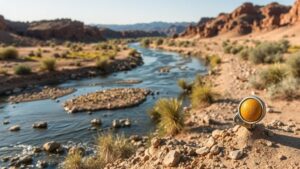Following Natural Pathways in Wetlands to Locate Buried Relics
Following Natural Pathways in Wetlands to Locate Buried Relics
Wetlands serve as critical ecosystems characterized by their saturated soil, diverse flora and fauna, and rich historical significance. For archaeologists and treasure hunters alike, wetlands are more than just natural reserves; they are lively landscapes that can conceal relics of past civilizations. The concept of following natural pathways in these environments opens new avenues for uncovering artifacts and understanding historical contexts. This article explores the methodology, benefits, and implications of utilizing natural pathways in wetlands for locating buried relics.
Understanding Wetland Ecosystems
Wetlands are areas where water covers the soil, either permanently or seasonally, creating unique habitats for various species. This ecosystem includes marshes, swamps, and bogs, each providing critical niches for wildlife. The importance of wetlands extends beyond biodiversity; they also act as natural buffers against floods, improve water quality, and serve as carbon sinks.
The physical characteristics of wetlands often dictate their potential for archaeological discoveries. For example, the anaerobic conditions created by waterlogged soils can preserve organic materials that would typically decay in drier climates. Artifacts made from wood, plant fibers, and even bones can be remarkably well-preserved, as evidenced by various archaeological sites across the globe.
Natural Pathways: Definition and Context
Natural pathways in wetlands refer to the routes formed by water flow, animal movements, and even seasonal climatic changes. These can include:
- Streambeds and riverbanks
- Trail systems established by wildlife
- Areas of sediment deposition
Understanding these pathways is crucial for archaeologists because artifacts often accumulate along these natural routes, either because they were used along these paths or washed down by water flow. For example, archaeological excavations along the banks of the Thames River in London have revealed numerous artifacts ranging from prehistoric tools to Roman coins, clearly indicating the importance of this natural pathway in human settlement and activity.
Methodology for Locating Buried Relics
To effectively locate relics in wetlands through natural pathways, a structured methodology is essential. The process generally involves the following steps:
- Initial Research: Start with historical maps and records to identify potential areas of interest.
- Field Surveys: Conduct initial field surveys to spot visible artefacts or changes in vegetation that may indicate human activity.
- Geophysical Surveys: Use technology such as ground-penetrating radar (GPR) and electromagnetic induction to identify buried structures without excavation.
- Excavation: After pinpointing a potential site, conduct careful excavations, maintaining a focus on preservation given the delicate nature of wetland soils.
Real-world applications of these methodologies can be seen in projects like the archaeobotanical surveys conducted in the waterlogged areas of Lake Nemi, Italy, where well-preserved boat relics were uncovered, shedding light on ancient Roman naval technology. Such methodologies maximize the potential for discovery while minimizing environmental impact.
Case Studies: Successful Discoveries in Wetlands
Several notable discoveries in wetlands underscore the effectiveness of following natural pathways. One significant case is the uncovering of the “Clovis Culture” tools in the Blackwater National Wildlife Refuge in Maryland. Researchers utilized the historical understanding of animal movement through wetlands to locate a series of ancient tools embedded in the soil, revealing insights into the early human inhabitants of the Americas.
Another example is the Neolithic site at Tulln, Austria, where extensive wetlands yielded exceptional findings, including pottery and tools, all positioned along former riverine pathways. The findings helped archeologists reconstruct the daily lives of ancient societies that thrived in these damp environments.
Challenges and Considerations
While following natural pathways can increase the chances of discovering buried relics, it is not without its challenges. Wetland environments often present logistical difficulties such as:
- Access and Mobility: The saturated ground can hinder physical access, necessitating specialized equipment.
- Environmental Regulations: Archaeological activities in wetlands are often subject to strict environmental protection laws that must be adhered to.
- Preservation Concerns: Disturbing wetland soils can impact their ecological balance and lead to irreversible damage to the site.
Addressing these concerns involves a multidisciplinary approach, incorporating environmental science with archaeology to foster sustainable research practices. Collaboration with ecologists and environmental conservationists ensures that archaeological efforts do not compromise the integrity of these crucial ecosystems.
Actionable Takeaways
To wrap up, following natural pathways in wetlands offers a promising strategy for locating buried relics. By understanding the dynamics of wetland ecosystems and employing systematic methodologies, archaeologists can uncover artifacts that provide critical insights into human history. successful integration of technology and traditional excavation practices enhances the potential for discoveries while promoting ecological stewardship. For anyone interested in excavation, consider the following actions:
- Engage in preparatory research about local wetland ecosystems.
- Use geophysical survey techniques to minimize site disturbances before excavation.
- Collaborate with environmental specialists to ensure both archaeological and ecological integrity.
By adhering to these guidelines, archaeologists and historians alike can contribute to a deeper understanding of our past while preserving the vital ecosystems in which these relics reside.


